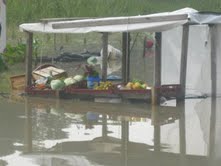Flood Damage to Farms Throughout Northeast from Irene
The result has been near complete devastation of the farmers’ crops (See attached pictures). Early Monday morning, Nuestras Raices staff realized the river was rising quickly and they immediately told the farmers to salvage as much of their crops as possible. Program Manager, Jesus Espinosa, estimated that farmers were able to salvage about 20-10% of the crops.
By Monday night, the flooding was so high that the farmers could no longer go out to their fields because of safety concerns. By Tuesday morning, the flooding was noticeably worse. The small bridge connecting the main field to the smaller field that is nearby the main entrance to the site was destroyed by the flood.
Espinosa has been in touch with Congressman John Olver about the devastation and has reached out the the Holyoke Mayor. The organization has no insurance to cover the enormous loss the farmers suffered, and they are currently looking for other means of support.
The massive devastation of this farm in Holyoke is just one example of damage caused throughout the Eastern United States by Hurricane Irene. Many other farms located along river beds, including many in Western Massachusetts, were also devastated by flooding following Irene.
As climate justice advocate Bill McKibben has pointed out, the atmosphere is about four percent wetter than it was 40 years ago, due to climate change caused by greenhouse gas emissions. This is because warm air hold more water than cold air. The greater intensity of storms that we’ve seen in recent years, including but not limited to Irene, is clearly an effect of climate change. Preparing to deal with increasingly volatile storm systems in a way that seeks justice must be a major priority of the organic and sustainable agriculture movements.
Since 2010, NOFA/Mass has partnered with Nuestras Raices, offering training support for the farmers at La Finca.
For more information on Nuestras Raices, see: https://www.nuestras-raices.org/




 Your Privacy Choices
Your Privacy Choices
Leave a comment